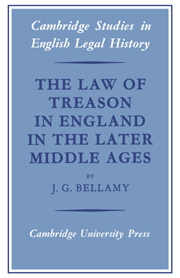Book contents
- Frontmatter
- Contents
- Editor's Preface
- Preface
- List of Abbreviations
- 1 The Medieval Concept of Treason
- 2 The Treatise Writers and the English Law of Treason at the End of the Thirteenth Century
- 3 The Origins of the English State Trial
- 4 The Great Statute of Treasons
- 5 The Scope of Treason, 1352–1485
- 6 Treason before the Courts, 1352–1485
- 7 The Origins and the Early History of the Act of Attainder
- 8 Treason and the Constitution
- Appendixes
- Select Bibliography
- Index
7 - The Origins and the Early History of the Act of Attainder
Published online by Cambridge University Press: 14 October 2009
- Frontmatter
- Contents
- Editor's Preface
- Preface
- List of Abbreviations
- 1 The Medieval Concept of Treason
- 2 The Treatise Writers and the English Law of Treason at the End of the Thirteenth Century
- 3 The Origins of the English State Trial
- 4 The Great Statute of Treasons
- 5 The Scope of Treason, 1352–1485
- 6 Treason before the Courts, 1352–1485
- 7 The Origins and the Early History of the Act of Attainder
- 8 Treason and the Constitution
- Appendixes
- Select Bibliography
- Index
Summary
Parliament was the scene of most of the state trials and faction battles of the fourteenth century. It was natural that this should be so since on the one hand any magnate accused of activity against the crown usually had the right to be tried by his peers, while on the other any successful baronial insurrection needed the aura of a parliamentary settlement, both to remove the stigma of its treasonable origins and to provide for suitable government in the future. Whoever the victor of any political confrontation, once the royalists had adjudged the contrariants or vice versa, the need was felt to pronounce penalties on the hard core of the vanquished. Initially the punishment was part of the judgement in parliament but after Richard II's revenge against Gloucester, Arundel and Warwick in the session of 1397–8 the judicial process almost disappeared and the pronouncement of penalty came to stand by itself. This was the act of attainder. The period of evolution came to an end in 1459 when the Yorkist leaders were proscribed by act of parliament without, or so it seems, any previous judicial process. Those who were the victims were not given the opportunity to answer but had to watch from afar while they were condemned as traitors and their heirs disinherited. A fashion was set and until the end of the century the king de facto periodically proscribed his enemies in this way. The opinion of historians has been that it was nothing less than judgement by legislation and as such one of the most unsavoury features of English medieval government.
- Type
- Chapter
- Information
- The Law of Treason in England in the Later Middle Ages , pp. 177 - 205Publisher: Cambridge University PressPrint publication year: 1970
- 1
- Cited by

